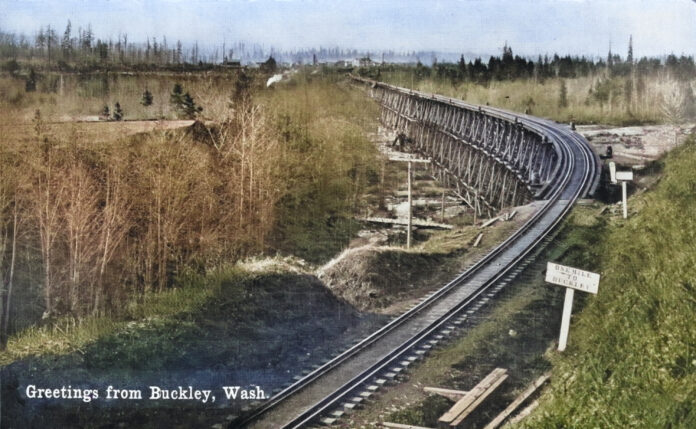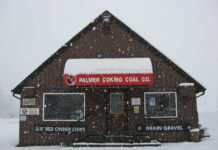Between Enumclaw and Buckley runs a mighty waterway, the White River, so named due to its milky color. It flows about 75 miles from its source at the Emmons Glacier on Mt. Rainier, to where it joins the Puyallup River in Sumner and eventually discharges into Tacoma’s Commencement Bay. The White River also marks much of the boundary between King and Pierce counties.
Animals, Native Americans, and the settlers who began to pour into the region in the 1850s typically followed rivers as they provided the best travel ways with the easiest grades. The Longmire and Biles wagon trains left Council Bluff, Iowa in 1853 on the Oregon Trail bound for the Puget Sound. Near Yakima, they traversed the Cascade Range using Naches Pass, a trail local Indian tribes had used for centuries. On the west side of the mountains, the wagon trains followed the White River down to their final destination, Puyallup. They would have passed by this location.
Just over a decade later, Northern Pacific Railroad obtained a Congressional charter to build a transcontinental railroad from Minnesota to the West Coast along a northern route. By 1873, Northern Pacific chose Tacoma for its railroad’s western terminus and the following year began constructing a rail line eastward from Tacoma to Wilkeson. Coal had recently been discovered along the Carbon River, and this rail route promised paying customers plus connection to the rail line being built from the east. That railroad reached Yakima in 1886, but a 77-mile gap remained, and millions of acres of land grants lay in the balance. Those millions of acres of valuable land would only be awarded to Northern Pacific after a direct rail line was completed.
The railroad chose a connection that crossed the White River between Buckley and Enumclaw, then turned east at Palmer-Kanaskat following the Green River up to Stampede Pass. From Yakima, the railroad was extended west through Ellensburg and within a nearly two-mile tunnel constructed under Stampede Pass. On May 27, 1888, the first train passed through that tunnel providing a direct route to the Puget Sound. Rail service was fundamental to the establishment of the new town of Enumclaw and the growth of nearby Buckley plus the Pierce County coal mining communities of Wilkeson, Carbonado, Burnett, Spiketon, Fairfax, and lesser towns and mill sites served by extensions.
This 1905 photo by E. Skamser showcases the Northern Pacific railroad bridge looking west along a curving timber trestle. The sign to the right in the foreground states, “One Mile to Buckley.” Boise Creek flows into the White River within 100 feet of where this picture was taken. The original bridge was rebuilt several times due to washouts from flooding.
Over the past several years the Foothills Rails-to-Trails coalition has spearheaded efforts to construct a new pedestrian bridge adjacent to this historic site where the old highway bridge previously crossed. Within the past few months the initial bridge framework consisting of a bowstring truss design was installed on ten 30-foot-deep concrete foundation shafts adding to three existing piers. This photo number JMF04-02904.2J.M. from the James M. Fredrickson Collection, originally a post card comes courtesy of the Pacific Northwest Railroad Archive housed in Burien, WA. Photo enhancements and colorization were performed by Doug “Boomer” Burham, doing business as www.BoomersPhotography.com
Jean Contreras of the Foothills Historical Museum in Buckley supplied additional information about both the historic railroad bridge and the new pedestrian bridge currently under construction.







